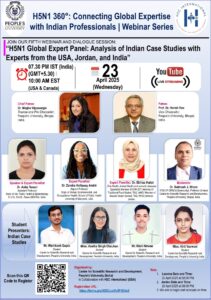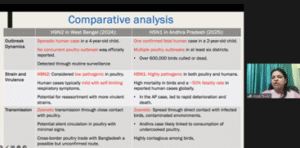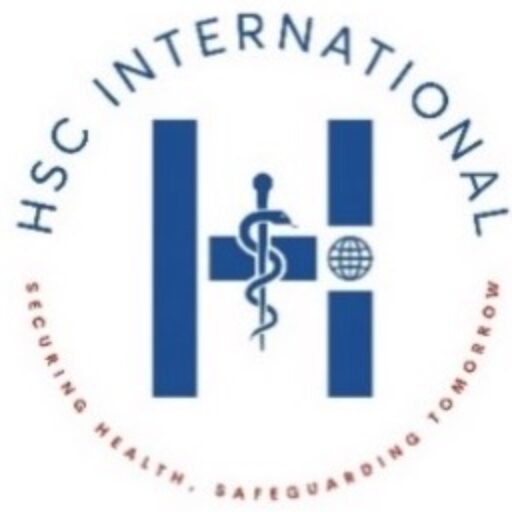

April 23, 2025
The threat of H5N1 avian influenza continues to evolve globally, requiring unprecedented levels of international collaboration and adaptive response strategies. HSC International’s latest H5N1 360° webinar brought together leading experts from three continents to examine critical case studies from India, offering valuable insights into how different regions can strengthen their preparedness against this persistent zoonotic threat.
Building Bridges Between Global Knowledge and Local Action
The fifth session of the H5N1 360° Webinar Series demonstrated the power of collaborative expertise, featuring Dr. Zandra Holloway from the University of Maryland, Dr. Ekhlas Hailiat from Jordan’s One Health expert panel, and Dr. Anita Tiwari from India’s NDVSU. Together with dynamic student researchers from People’s University, Bhopal, they analyzed real-world outbreak responses across multiple Indian states, revealing both successes and critical gaps in current preparedness strategies.
What made this session particularly compelling was its focus on practical implementation. Rather than theoretical discussions, participants examined actual outbreak timelines, response mechanisms, and economic impacts from recent H5N1 and H9N2 cases in West Bengal, Andhra Pradesh, and Maharashtra.
The Stark Reality of Regional Differences
The case studies painted a sobering picture of how the same virus can manifest differently across regions. In West Bengal, a four-year-old child infected with H9N2 recovered fully, but the incident revealed critical gaps in diagnostic timelines—taking nearly four months from symptom onset to final confirmation. Meanwhile, in Andhra Pradesh, a two-year-old girl tragically died within 15 days of H5N1 infection, highlighting the aggressive nature of highly pathogenic strains.
These contrasting outcomes underscore a crucial reality: one-size-fits-all approaches to H5N1 preparedness are inadequate. As Dr. Tiwari emphasized during her presentation, regional differences in agricultural practices, seasonal migration patterns, and healthcare infrastructure require tailored surveillance and response strategies.
Jordan’s Success Story: A Model for Prioritization
Dr. Ekhlas Hailiat shared Jordan’s innovative approach to zoonotic disease management through systematic prioritization. Rather than attempting to address all potential threats simultaneously, Jordan identified five priority diseases—later expanding to seven—and developed specific action plans for each. This focused approach enabled more effective resource allocation and clearer response protocols.
“The country cannot take all the zoonotic diseases in concentration,” Dr. Hijazi explained. “So they can prioritize the zoonotic disease in the country.” Jordan’s model demonstrates how strategic focus can yield better outcomes than scattered efforts across multiple disease threats.
The Economic Dimension of Preparedness
The webinar revealed significant economic implications often overlooked in technical discussions. Maharashtra’s H5N1 outbreaks resulted in the culling of thousands of birds, with government compensation of only 1.2 crore rupees falling far short of actual losses. This economic gap creates ongoing vulnerability, as affected farmers struggle to rebuild their operations with adequate biosecurity measures.
Consumer confidence impacts compound these challenges. Even in areas without confirmed outbreaks, poultry prices dropped significantly due to public concern. West Bengal saw chicken prices fall from 220 to 200 rupees per kilogram, demonstrating how fear can create economic impacts that extend far beyond actual outbreak zones.
Student Voices: The Next Generation of One Health Leaders
Perhaps most encouraging was the contribution from student researchers who presented sophisticated analysis of outbreak patterns, transmission routes, and comparative response strategies. Their work on Maharashtra outbreaks and Australia-India transmission connections demonstrated how academic institutions are cultivating the next generation of One Health professionals.
These young researchers didn’t just present data—they offered thoughtful analysis of biosecurity gaps, seasonal transmission patterns, and the importance of community engagement in surveillance efforts. Their emphasis on connecting global trends with local realities reflects a maturing understanding of how zoonotic disease management must operate across multiple scales simultaneously.
Five Years of Progress, But Gaps Remain
Dr. Holloway’s assessment of global preparedness painted a picture of significant progress tempered by persistent challenges. “We’ve made considerable progress from when we started,” she noted, citing improved transparency in reporting, enhanced community-based surveillance, and better-trained rapid response teams.
However, the COVID-19 experience revealed that progress isn’t uniform. While technical capabilities have advanced, the economic pressures that discourage transparent reporting of animal disease outbreaks remain powerful. Countries still struggle with the tension between rapid outbreak reporting and the immediate economic consequences of such transparency.
The Technology Integration Challenge
The discussion revealed both opportunities and obstacles in leveraging technology for H5N1 preparedness. While electronic integrated surveillance systems offer significant advantages for real-time data sharing between human and animal health sectors, implementation requires substantial investment and coordination between multiple agencies.
Dr. Hailat emphasized the importance of rapid diagnostic capabilities at border crossings and airports, where early detection could prevent broader transmission. However, this requires training healthcare workers to recognize zoonotic disease symptoms and having appropriate testing capabilities readily available.
Building Resilient One Health Systems
The webinar reinforced that effective H5N1 preparedness extends far beyond clinical response capabilities. True resilience requires integration across multiple domains: veterinary surveillance systems that can detect early warning signals, public health infrastructure capable of rapid human case management, environmental monitoring that tracks viral evolution, and economic support systems that encourage rather than penalize transparent reporting.
India’s development of indigenous H5N1 vaccine capabilities, announced by ICMR during the webinar timeline, represents the kind of strategic investment needed for long-term resilience. However, vaccine development must be coupled with distribution strategies that can reach both commercial poultry operations and backyard farmers in rural communities.
Looking Forward: Sustained Commitment Required
As the global community continues grappling with zoonotic disease threats, this webinar highlighted both reasons for optimism and areas requiring urgent attention. The quality of international collaboration demonstrated through the HSC International-People’s University partnership shows how academic institutions can contribute meaningfully to global health security.
However, success requires sustained commitment rather than crisis-driven responses. As participants noted, diseases like H5N1 don’t respect borders or bureaucratic boundaries. Effective preparedness demands continuous investment in surveillance infrastructure, ongoing capacity building, and flexible response systems that can adapt to evolving threats.
The 840 participants from 18 countries who joined this webinar represent a growing global network committed to One Health approaches. Their engagement suggests increasing recognition that zoonotic disease preparedness isn’t just a technical challenge—it’s a collaborative imperative that requires sustained international cooperation.
The question isn’t whether future H5N1 outbreaks will occur, but whether the global community will be adequately prepared when they do. Sessions like this one provide both the knowledge exchange and relationship building essential for effective preparedness. The real test will be translating these insights into sustained action at local, national, and international levels.

